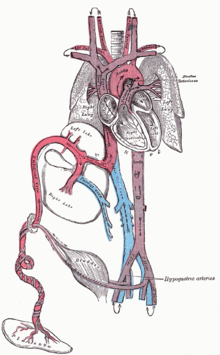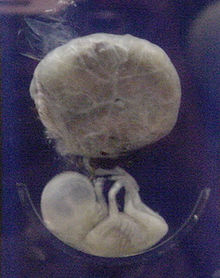fetus
A fetus or fetus (from latin fetus , "breed progeny"; alternative spellings FoET and Fet , plurality each fetus or fetuses ) is an early stage in the individual development (ontogeny) of the amniotic vertebrates (Amniota) and in particular the higher mammals ( Placentalia) including humans. It begins with the development of the internal organs and ends with hatching or birth . The previous stage of development is called an embryo , but it is not uncommon for the entire prenatal stage of life to be called an "embryo" for reasons of linguistic simplicity.
In the higher mammals, both the beginning and the duration of the fetal period are different and depend on the total duration of the gestation period and the degree of maturity of the newborn. In humans, whose pregnancy usually lasts 9 months , the fetal period begins in the 9th week, i.e. it lasts about ¾ of the entire pregnancy. In small rodents ( hamsters , mice ) with a total gestation period of barely more than three weeks, however, the fetal period does not begin until the third week of gestation and is therefore only about ¼ of the total gestation period.
Fetal circulatory system
The prenatal blood circulation in a human fetus is very different from the circulation after birth . This is mainly due to the fact that the lungs are not used. The supply of oxygen and food takes place via the placenta ( placenta ) and the umbilical cord .
Development of the human fetus
(The following information is indicative, individual time differences may occur)
- Embryo: The heartbeat starts in the 3rd week after fertilization.
- 5th-8th Week: The organs develop.
- 15th week: The fetus is becoming increasingly "human". Optical determination of gender is possible.
- Week 18: The fetus opens its mouth and swallows amniotic fluid . The digestive system works and taste buds develop in the mouth.
- 19th week: Perceptible movements of the fetus (child movements) and audible heart sounds.
- From the 20th week: The cerebral cortex is created and experiences are stored in it.
- Week 21: The iris of the eye is developing.
- 24th week:
- The alveoli have developed. Up to the 30th week, a surface film ( surfactant ) forms in the alveoli , which later prevents the alveoli from collapsing by reducing their surface tension. In the event of premature birth, the infant may therefore have to be given artificial surfactant in the lungs to enable adequate breathing.
- The lens of the eye is held in place by a muscle.
- 24.-26. Week: The inner and middle ear are fully developed, the nerve tracts of the auditory canals are wrapped with insulating myelin. Heartbeat, speech and breathing sounds of the mother as well as outside noises (from 90 decibels volume) can be heard.
- 7th month: the fetus recognizes the mother's voice.
- 26th week: eyelids are developed, the eyes partially open.
- 28th week: The tissue plug loosing, which previously closed the nostrils. The fetus can smell (experiments with premature babies confirm this).
- 30th week: A surface film (surfactant) forms on the alveoli, which enables breathing.
- 30.-34. Week: In male fetuses deszendiert testicular → rises in the scrotum.
- The eyes can be moved in the eye socket and the fetus can perceive optical sensory impressions and react e.g. B. on strong light.
- The fetus is fully developed. Until birth he will still grow and gain weight.
- 32-33 Week: The sucking reflex develops. Children born prematurely cannot suckle on their own.
- Birth: When the lungs are mature, there is so much surfactant protein in the amniotic fluid that the formation of oxytocin is stimulated. Oxytocin causes the uterus to contract, causing childbirth and placenta rejection. At the same time, this hormone also stops the bleeding in the uterus.
Newborn babies have visual acuity around 0.03. You are able to accommodate . Color perception can only be detected about two months after birth.
Most of the brain's nerve cells are already present at birth. Due to the initially small brain volume, the baby fits through the birth canal. The volume of the brain increases from 0.35 liters (at birth) to around 1.35 liters (in adults). It does this by sheathing the nerve lines with insulating myelin fat. The fat content in the adult brain is approx. 60%. This increases the transmission speed of the nerve impulses in the brain from 3 m / s (fetus / newborn) to approx. 110 m / s (adult).
Terminology in humans

Depending on the gestational age or depending on the birth process , one and the same human being is called either a zygote , morula , blastocyst , embryo (from the 3rd week), fetus (from the 11th week) or child . The lack of use of possible connecting over terms is often criticized (eg. Human ), demonstrating that it is in each case the same creatures are, and discrimination only on the basis of development steps made is: "The assessment of the gestational age belongs to the realm of descriptive ethics , it is a description of moral practice. ”The time limits for the terminology can therefore be variable depending on the situation, since the value is based on certain development points of the embryo or the fetus. For example, " during birth [...] the fetus is treated like a child - this applies to a fetus that is born in the 24th week of pregnancy, as well as to a mature child."
In law, the terms nasciturus and nondum conceptus are used.
See also
- Embryonic development
- Fetus in foeto
- Therapy in utero
- Embryo Protection Act
- Newborn
- Blood exchange transfusion
- Fetopathies
Web links
Individual evidence
- ↑ cf. Bertram Schnorr, Monika Kressin: Embryology of Pets. Thieme Verlag, 2011, ISBN 3-8304-1147-2 , p. 82 ( GoogleBooks )
- ↑ a b c Ulrich Drews: Pocket Atlas of Embryology. Thieme Verlag, 2006, ISBN 3-13-109902-X , p. 32 ( GoogleBooks )
- ↑ a b Barbara Maier: Ethics in Gynecology and Obstetrics. Decisions based on clinical case studies. Springer Verlag, 2000, ISBN 3-540-67304-0 , p. 117 ( GoogleBooks )

